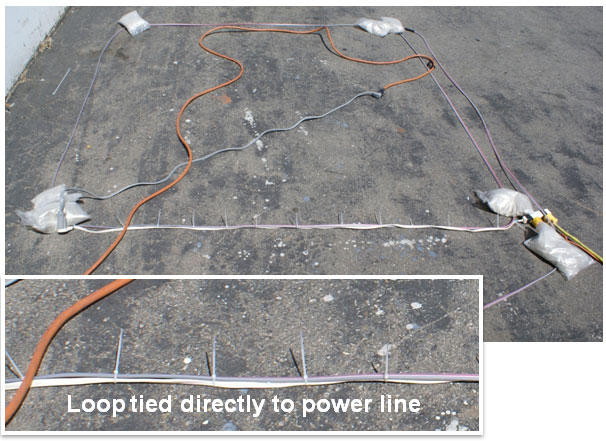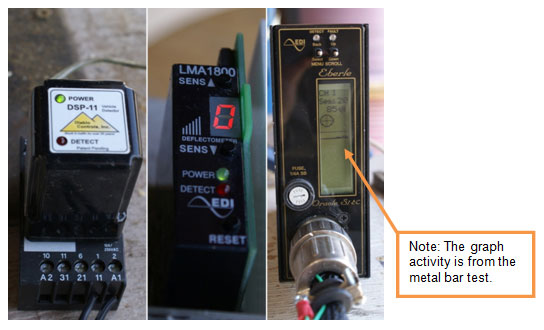Tests & Results
Loops and Power Lines
Purpose:
- Observe and record the affect power lines have on loop performance.
Hypothesis:
When the loop is connected to a fully featured detector module there will be no visible/recordable effect. Loop may experience interference when connected to a more basic detector module.
Materials:
- BD Loops preformed saw-cut loop made with 16AWG wire. Both loop and lead-in section are made with untwisted jacketed wire.
- 1 – SC 24-20 (4’x8′ or 6’x6′ (24′ perimeter) loop with a 20ft lead-in)
- 1 – EDI Detector Model#LMA-1800 (detector has a deflector meter to show how much an object changes the inductance of a loop)
- 1-EDI Oracle Detector Model – Detector has 20 levels of sensitivity.
- 1 Diablo DSP-11
- Sand bags to hold loop in place
- Untwisted power extension cords.
- Power Tools: Heat Lamp, Shop Vac, Table Saw, Grinder, and 3 Heat Guns.
Procedure:

We laid out a 6’x6’ preformed direct burial loop and directly tied an untwisted power line directly to one of the loop’s legs with cable ties. Approx. 15’ of Twisted and untwisted power lines were laid over the loop.
The loop was connected to 3 different detectors set to the highest sensitivity and the power was surged (turned on and off) to see if any crosstalk or false detections occurred. Each detector was tested by holding a metal bar over the loop to check if they were able to obtain a proper detection.
The detection test with the metal bar was repeated when the power was being surged to see if there would be any interference.
Power tools were connected to the power lines until the circuit popped. The circuit was overloading at 44.5 amps.
| Power Tool | Amps |
| Heat Lamp | 2.5 |
| Shop Vacuum | 1 |
| Table Saw | 2 |
| Grinder | 3 |
| Heat Gun | 13 |
| Heat Gun | 13 |
| Heat Gun | 13 |
| Total: | 44.5 or 4,895 watts |
Results:

| EDI LMA 1800 | |||
| Sensitivity Level: 9 (Highest) | False Detection: No | Crosstalk: No | Detect Metal Bar: Yes |
| EDI Oracle | |||
| Sensitivity Level: 20 (Highest) | False Detection: No | Crosstalk: No | Detect Metal Bar: Yes |
The EDI Oracle has a DEFLECTOMETER® streaming graph which shows the call strength over time (in 6 second intervals) The streaming graph showed no activity when the power was on or surged, it only showed activity when the metal bar was placed over the loop to check the detector.
| Diablo DSP-11 | |||
| Sensitivity Level: N/A | False Detection: No | Crosstalk: No | Detect Metal Bar: Yes |
Results show that all the detector modules did not experience interference, or false detections when the power was on or when the power surged. There were no false detections or interference recorded on any of the detector modules.
Conclusion:
Loops laid over power lines are unlikely to experience false detections or interference for most common applications.
What this means, BD Loops comments:
This is a frustrating myth that BD Loops has been trying to combat since 2013. As you can see in the test results all 3 detectors did not experience cross talk or false detections during the test. We added more power tools until we were able to trip the
circuit breaker. Even with the overloaded circuit no cross talk or false detections occurred.
Standard gate power feed ranges from 200-300 watts on average, our test surge went up to 4,895 watts (or over 10x).
This is something that we find puzzling, the NEC (National Electric Code) requires that power lines be direct buried at least 24” below the surface (18” if under concrete slab). When power lines are run in a non metallic raceway the NEC requires a minimum burial depth of at least 18” below the surface (12” if under concrete). NEC does not apply to inductance loops.
If there is no interference from power lines tied directly to a loop, where did the 3’ standoff from electrical lines recommendation that is taught in gate and door industry schools come from? Why on earth would we need harder to follow standoff guidelines than the NEC? I would like to see the testing that determined this standard, it appears to be based on hearsay.
Power lines are often run under the driveway, keeping a 3’ stand off distance from electrical lines would make installing inductance loops impossible for a large number of applications. Why are industry schools teaching installers “installation standards” with no supporting evidence? Why are these schools making it harder to installers to do their jobs?
BD Loops
The Loop Experts!
BD Loops was founded in 2001. Their preformed loops and accessories are designed with the installer in mind. BD Loops offers a complete loop system solution including preformed direct burial loops, preformed saw-cut loops, loop sealant, blades, testing devices, and installation tools. BD Loops has a reputation for reliability and ease of installation. They pride themselves on the quality of their products and their commitment to providing excellent customer service and support. BD Loops preformed loops are made in the USA at their facility in Placentia, CA.

